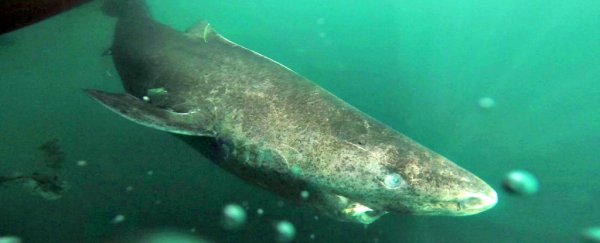Scientists have discovered that the mysterious Greenland shark can live to roughly 400 years old - and possibly even older - deep below the Arctic sea.
To put that into perspective, it means there could be sharks alive today that were swimming when the Mayflower brought the first pilgrims to America, and when Isaac Newton came up with this theory of gravity.
An analysis of 28 female Greenland sharks showed that the oldest individual was at least 272, and could have been as old as 512, making it the longest living animal with a backbone - that we know of.
The scientists predict that she was most likely around 390 when she was accidentally captured by a research vessel.
Before this, the oldest vertebrate was the bowhead whale, which can live up to 211 years.
This new research suggests that the Greenland shark could survive almost twice that long - and further research into the species could reveal some important secrets about how to slow down the ageing process in humans.
For those who aren't familiar, the Greenland shark is an elusive carnivore that lives in the frozen waters of the Arctic sea.
The sharks grow to more than 5 metres in length, and swim sluggishly through the deep, cold waters, only coming close to the surface to feed on large fish and marine mammals such as seals (Inuit legends talked about them feeding on humans in kayaks, but that's never been confirmed).
It's always been suspected that the sharks could live a long time, based on how large they are, and how slowly they grow (around 1 cm per year), but seeing as we hardly ever catch a glimpse of these giants, we've never been exactly sure.
"We only expected that the sharks might be very old," lead researcher Julius Nielsen, from the University of Copenhagen in Denmark, told NPR. "But we did not know in advance. And it was, of course, a very big surprise to learn that it was actually the oldest vertebrate animal."
To figure this out, the researchers analysed 28 female Greenland sharks that had been accidentally pulled up by research vessels as by-catch between 2010 and 2013.
Traditional ageing methods don't work on Greenland sharks, because they don't have calcified tissues that deposit in growth layers for researchers to analyse.
But Nielsen found that there are crystallised proteins inside the lenses of their eyes that build up throughout their lifetime, and act in much the same way.
Because of this, the team could perform radiocarbon dating on the lens proteins, - and straight away noticed that the oldest tissue samples lacked the tell-tale carbon-14 signature released by nuclear weapons testing in the 1960s, so those animals had to be at least older than 50.
The team is reluctant to give exact numbers, but they found that the two largest individuals were around 335 ± 75 years, and 392 ± 120 years. So that means the oldest female could have been anywhere from 272 to 512.
The find brings both good and bad news - the bad news being that the team also showed that the sharks only reach sexual maturity at around 150 years old, which means it takes a really long time to replace any individuals killed by fishing or climate change.
"Our results show that the Greenland shark is the longest-lived vertebrate known, and they raise concerns about species conservation," the team concludes in Science.
The good news is that by finally getting a little bit of insight into the species life cycle, we might have a better chance of being able to protect it in future. And it could also hold the key to anti-ageing treatments in humans.
In fact, one of the only animals that's able to outlive the Greenland shark might be the ocean quahog - a type of clam that's been dated to at least 507 years old.
One thing that these two species have in common, along with the bowhead whale, is that they all live in incredibly cold northern waters, which ageing specialist Steven Austad from the University of Alabama, Birmingham - who wasn't involved in the study - thinks could have something to do with their longevity.
Although there's likely a lot more going on that we're not aware of as yet.
"I don't think that cold is the whole story," he told NPR. "It's probably playing a role. But my guess is there are plenty of short-lived animals that are swimming around with this shark."
What he's more interested in are the muscles of these shark species, which have been swimming and working hard since the 17th century. If we could figure out how to grow these muscle cells in the lab, we might be able to learn their secret.
"Probably whatever sort of physiological tricks the sharks have to live that long, and the quahogs have to live that long, they're probably something that humans don't have," he said. "But it's something that, if we discover what it is, we might be able to adapt it to human use."
